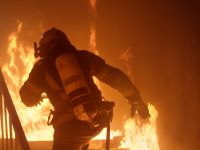The devastating earthquakes that struck Qazvin in the Islamic Republic of Iran this week may have hit a Chemical Weapons manufacturing and storage facility. Conflicting Iranian reports of the number of casualties and a visit to the scene by Iranian president Khatami have given rise to rumors that local civilians were exposed to highly dangerous nerve gasses.
The earthquake, measuring 6.3 on the Richter scale, struck Qazvin province and its capital of the same name on Saturday, June 22. Three days later, an aftershock measuring 4.0 on the Richter scale hit the stricken province again.
American sources have long reported the existence of a large chemical weapons plant at the provincial capital of Qazvin, located inside the very city itself. The Center for Strategic & International Studies (CSIS) reported as early as 1998 that the facility, supposedly a pesticide plant, was in reality a production line for highly lethal poison gas. CSIS noted that the plant had been completed around 1988. The non-aligned Federation of American Scientists (FAS) also reported that India had assisted the Iranian chemical weapons program by the construction of a major new plant at Qazvim to manufacture phosphorous pentasulfide, a precursor for nerve gas.
The Iranian reaction to the earthquake in Qazvin has lead to speculation that the secret plant, with its store of deadly chemicals, had been struck. Official Iranian reports first told of about five hundred people killed, but this figure was suddenly and inexplicably changed to about 230. This "about-face" induced rumors of a cover up of the fact that countless civilians had been exposed to the nerve gas in their city.
President Khatami’s quick visit to Qvazin has also raised several questions. Arriving three days after the quake, the president made his way directly to the city where the supposed chemical weapons plant was located.
Two days earlier, the Interior minister's convoy was attacked by a mass of local residents. The official reports stated that the city’s inhabitants were angered at the fact that aid had not been dispatched to them for several days after the earthquake struck Qvazin. This seems odd, given the fact that Qvazin was at the center of the quake and hardest hit, and has given rise to suppositions that a fear that chemical weapons had been released in the city kept officials and aid away from Qvazin during crucial days.
Iran signed the Geneva Protocol, which prohibits chemical warfare, as early as 1929. However, it has in the past two decades reportedly pursued a program of developing such weapons; Iran’s chemical warfare activities were a direct response to the use of such weapons against Iranian troops in the Iran Iraq war that raged throughout the 1980s. In November 1980, Tehran Radio broadcast charges of Iraqi chemical bombing at Susangerd.
Following more incidents in which chemical weapons were used, the Iranian leadership decided it had to develop such a capability of its own. CIA Deputy Director A. Norman Schindler told the United States Senate in September 2000 that Iran was still working to develop its ability to manufacture chemical warfare agents, and that it was stockpiling these deadly gases. The facilities at Qvazin were, apparently, a key part of this unconventional weapons program.
While little is yet known about the part that chemical weapons had or did not have in the recent tragedy, there is no doubting the immense scope of the disaster. Hundreds have died and thousands have become homeless - 12,000 according to offical Iranian reports, as much as 80,000 by the United Nations estimates. Qvazin has been struck a harsh blow. (Albawaba.com)
© 2002 Al Bawaba (www.albawaba.com)







